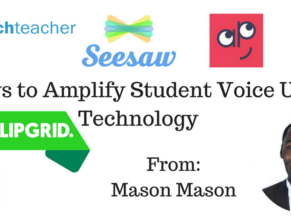Post by Instructor: Mason Mason. Follow him on Twitter @EdTechMason
Every student has a voice and deserves to be heard; however, sometimes it’s difficult for educators to amplify the voices of all of their students when they have class sizes of 30 or more students and can see upwards of 150 students in a single school day. Whether in a BYOD, one-to-one, or one-to-few device environment, educators can leverage technology to allow every student to share what they know, think, feel and understand in a meaningful way.
The following tools encourage discussion, reflection, and synchronous or asynchronous student response. Using technology inside and outside of the classroom not only gives students an opportunity to speak but also gives them a chance to be heard. Moreover, these tools can foster global collaboration if leveraged to their full potential
The digital tools below are each paired with a visible thinking routine; a procedure, process, or pattern of helping a student think about his or her thinking and learning. Making thinking visible enhances communication, understanding, and reflection of the learning and the learning processes. Using these technological tools and pedagogical strategies can help improve students’ understanding and content knowledge.
1) Flipgrid: Video Reflection
Devices: iOS, Android, Mac, or PC
Visible Thinking Routine: Think Pair Share
“Think Pair Share” is a routine that encourages collaboration, communication, reasoning, and explanation. And Flipgrid is a video-response tool that can be used on any connected device using the app or on the web. After completing an assignment, activity, or lesson, a teacher can have students Think Pair Share using Flipgrid by answering a question about a problem or topic to see multiple perspectives and ideas. When I taught Introduction to Radio and Television, I would often have my students stop to Think Pair Share when exploring various issues in mass media.
2) Recap: Q & A to Ignite Curiosity
Devices: iOS, Android, Mac, or PC
Visible Thinking Routine: I used to Think...Now I think…
“I used to Think...Now I think…” is a reflection routine that requires students to examine how and why their thinking has changed throughout a lesson, project, or unit of study. And Recap is another excellent video response tool teachers can have students use to make their thinking visible. For example, using Recap, a teacher can ask students to reflect on how and why their thinking might have changed after learning about and exploring a new topic. As an English teacher, I would have my students examine how their thinking changed about social and political issues after reading a novel.
3) Seesaw: The Learning Journal
Devices: iOS, Android, Mac, or PC
Visible Thinking Routine: See Think Wonder
“See Think Wonder” is a routine all about observation and exploration, asking students to notice what they see, think, and wonder about a piece of art or literature. Seesaw, a digital portfolio platform, lets students make their thinking visible through text, pictures, or videos. During a unit on consumer culture, one student group used Seesaw to document their analysis of online gambling ads, debating which online casino has the best payouts to understand marketing claims. As students explore art, literature, or music, teachers can have them document their evolving thoughts from surface observations to insightful analytical reflections. This strategy helped my students go beyond summary and forge perceptive connections to other works and real-world contexts.
4) Clips by Apple: Visual Evidence
Devices: iOS
Visible Thinking Routine: What Makes You Say That?
“What Makes You Say That?” is a routine that requires students to stop and think about their thinking and requires them to be able to articulate, interpret, and justify their answers. And Clips is one of Apple’s newest iOS applications that allow students to use filters, animations, and voice-to-text features to enhance their response. To promote evidence-based reasoning, teachers can have students express ideas using Clips to describe what’s going on and what evidence they have to support their claims.
5) Shadow Puppet Edu: Video Storytelling
Devices: iOS, Android, Mac, or PC
Visible Thinking Routine: Think Puzzle Explore
“Think Puzzle Explore” is another routine that promotes more in-depth inquiry and understanding by requiring students to reflect on what they know, what puzzles them, and what they want to know more about related to a topic. To foster deeper inquiry, teachers can have students use Shadow Puppet Edu, an elementary friendly video creation tool, to combine images, video, text, and voiceover to make their thinking visible about a topic.
Conclusion
Amplify your students’ voices by helping every student in your class find his or her voice and be heard with one of these digital tools. Teach them these visible thinking routines so that they may regularly discuss and reflect on their knowledge, skills, and understanding. Even the quietest student in class deserves to be heard.


